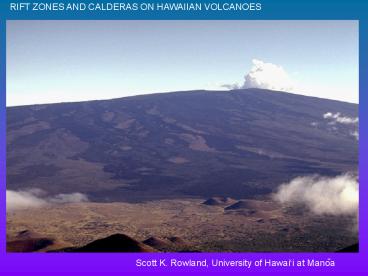RIFT ZONES AND CALDERAS ON HAWAIIAN VOLCANOES - PowerPoint PPT Presentation
1 / 37
Title:
RIFT ZONES AND CALDERAS ON HAWAIIAN VOLCANOES
Description:
RIFT ZONES AND CALDERAS ON HAWAIIAN VOLCANOES – PowerPoint PPT presentation
Number of Views:35
Avg rating:3.0/5.0
Title: RIFT ZONES AND CALDERAS ON HAWAIIAN VOLCANOES
1
RIFT ZONES AND CALDERAS ON HAWAIIAN VOLCANOES
2
Rift zones are major structural features on
Hawaiian shield volcanoes
3
Most Hawaiian volcanoes, especially when
theyre young, are elongate rather than round
in map view
4
Rift zones have the form of broad topographic
ridges, and are where flank eruptions occur
Topography of Mauna Loas SW rift zone (dark
flows post-date 1778)
5
Rift zones extend well offshore
6
(No Transcript)
7
A portion of Mauna Loas NE rift zone - each of
the gray areas is a lava flow, and following them
upslope leads to a 1-2 km-wide band, which is
the rift zone axis
8
(No Transcript)
9
Hawaiian volcanoes look kind of like big slugs
snuggled next to each other
10
We understand pretty well why rift zones develop
in a young volcano that is growing next to an
older neighbor that already has rift zones. We
dont understand why rift zones form in the
first place (e.g. on Kohala).
11
Rift zones are pretty obvious from earthquake
locations
12
If an eruption is going to occur along a rift
zone somewhere, magma has to get there from the
magma chamber. It does this as a blade-shaped
body of magma called a dike.
-Tracking the rock-breaking earthquakes allows
geologists to determine that most dikes
propagate at 1-2 km/hour. -Harmonic tremor tells
geologists that magma is continuing to flow
underground. Next time you are near a large
water pipe, put your hand on it and you will feel
harmonic tremor.
13
A curtain of fire (actually a curtain of lava)
occurs when a dike intersects the volcanos
surface. Most Hawaiian eruptions begin this way.
1971 eruption viewed from the Hawaiian Volcano
Observatory, photo by Hawaii Volcanoes National
Park staff
14
Solidified dikes are exposed by erosion on older
Hawaiian volcanoes
15
If a whole lot of dikes are exposed, it means
that erosion has exposed the core of an old rift
zone
16
old sea cave
17
There is even a place nearby where erosion has
exposed the side of a dike, not just the edge.
18
Dike rock is usually more resistant to erosion
than the lava flows that the dikes are cutting
through. They end up standing above the more
eroded flows to form narrow blade-like ridges.
19
DIKE DIMENSIONS
20
Rift zones on the surface of a young volcano are
marked by vents, gaping cracks and fissures,
young lava flows, and pit craters.
1 km
21
Pit craters form by collapse they are not
blasted out from below
person for scale
22
One mechanism that has been proposed to form pit
craters involves a process called stoping.
This involves the repeated collapse of the roof
of a cavity until the cavity breaks the surface.
This process has been observed to occur in old
mines.
(diagram from Walker 1988)
23
Another pit crater formation mechanism has been
proposed
In this scenario, you should expect to find pit
craters at the place where the ground fractures
come close to each other. This idea was
proposed by Chris Okubo, at the time a UH
undergrad.
24
Here is a small pit crater, Devils Throat,
very near to Chain of Craters Rd., in Hawaii
Volcanoes National Park.
photo by P. Mouginis-Mark
25
IS THERE A NON- GEOLOGY REASON TO CARE ABOUT
THE FACT THAT FLANK ERUPTIONS ON HAWAIIAN
VOLCANOES ALMOSTALWAYS OCCUR FROM RIFT ZONES?
26
(No Transcript)
27
CALDERAS ARE THE OTHER MAJOR STRUCTURAL
FEATURE ON HAWAIIAN VOLCANOES
28
(No Transcript)
29
Magma chamber processes, as long as there is
sufficient supply to keep the magma chamber from
solidifying
30
Complex migration of the center of inflation
prior to an eruption in 1967. During the
ensuing eruption, the deflation pattern was not
a reverse of the inflation pattern.
Fiske Kinoshita (1969)
31
(No Transcript)
32
5 km
33
Ryan et al. (1882)
34
Rift zones on Oahu are identified most easily by
mapping dike swarms.
35
Savaii (Samoa) has very prominent rift zones
marked by scoria cones
36
Karthala volcano on Grand Comoro (about 1/2-way
between Mozambique and Madagascar) is the
volcano most similar to Hawaiian volcanoes with
respect to rift zones and a caldera
37
PAU































